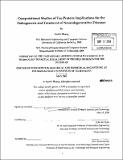Computational studies of tau protein : implications for the pathogenesis and treatment of neurodegenerative diseases
Author(s)
Huang, Austin V., 1980-
DownloadFull printable version (14.86Mb)
Other Contributors
Harvard University--MIT Division of Health Sciences and Technology.
Advisor
Collin M. Stultz.
Terms of use
Metadata
Show full item recordAbstract
Tau protein is the primary constituent of protein aggregates known as neurofibrillary tangles, a pathological hallmark of Alzheimer's disease (AD). Previous studies suggest that tau protein may play a contributing role in neurodegenerative diseases such as AD. Thus characterizing the structural properties of tau is critical to understanding disease pathogenesis. However, obtaining a detailed structural description of tau protein has been difficult because it belongs to a class of heteropolymers known as intrinsically disordered proteins (IDPs). Unlike most proteins, IDPs adopt many distinct conformations under physiological conditions. In spite of their disordered nature, evidence exists that such proteins may exhibit residual structural preferences. In this work, models of tau are constructed to characterize these structural preferences. We begin by performing molecular dynamics simulations to study the inherent conformational preferences of the minimal tau subsequence required for in vitro aggregation. To model residual structure in larger regions of tau, we developed a novel method called Energy-minima Mapping and Weighting (EMW). The method samples energetically favorable (cont.) conformations within an IDP and uses these structures to construct ensembles that are consistent with experimental data. This method is tested on a region of another IDP, p21 Wafl/Cipl/Sdil(14 5 -164 ), for which crystal structures of substrate-bound conformations are available. Residual conformational preferences identified using EMW were found to be comparable to crystal structures from substrate-bound conformations of p21 Wafl/Cipl/Sdil( 14 5 -164 ). By applying EMW to tau, we find disease-associated forms of tau exhibit a conformational preference for extended conformations near the aggregation-initiating region. Since an increased preference for extended states may facilitate the propagation of cross-[beta] conformation associated with aggregated forms of tau, these results help to explain how local conformational preferences in disease-associated states can promote the formation of tau aggregates. Finally, we examine limitations of the current methods for characterizing IDPs such as tau and discuss future directions in the modeling of these proteins.
Description
Thesis (Ph. D.)--Harvard-MIT Division of Health Sciences and Technology, 2009. "May 2009." Cataloged from PDF version of thesis. Includes bibliographical references (p. 133-147).
Date issued
2009Department
Harvard University--MIT Division of Health Sciences and TechnologyPublisher
Massachusetts Institute of Technology
Keywords
Harvard University--MIT Division of Health Sciences and Technology.